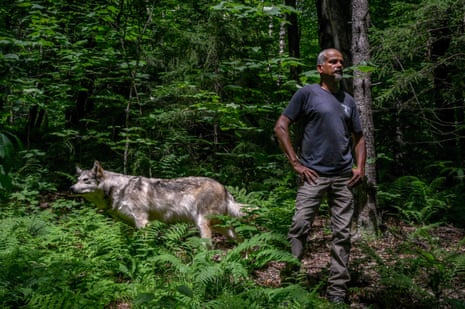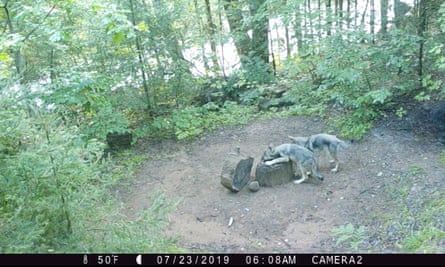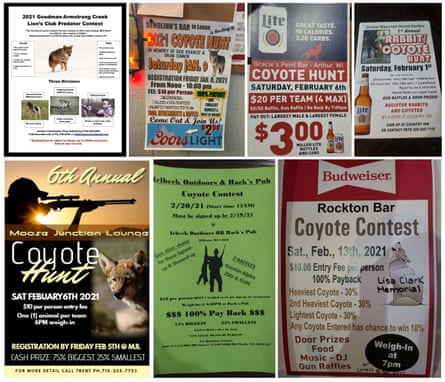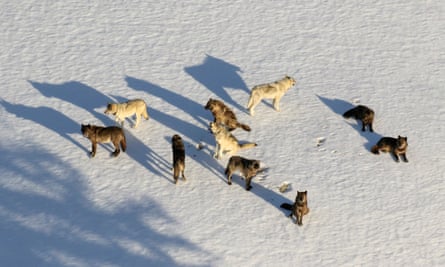The woods were full of the sounds of snowmobiles and baying hounds. A group of perhaps a dozen hunters had gathered to give chase to big game along a frozen creek in north-eastern Wisconsin.
Hound hunting, chiefly for black bear and coyote, is a popular pastime in this part of the state. But the houndsman who emerged from the hemlocks onto a snowy road around twilight held a different kind of trophy.
Flanked by a half-dozen of his buddies clad in ball caps and snow boots, the man hugged an enormous gray wolf to his chest, its head lolling against one shoulder and its tail nearly touching the ground.
The scene, captured on video by an environmental group known as Wolf Patrol, occurred on the opening day of last winter’s wolf hunting season – the first since the gray wolf was removed from the endangered species list by the Trump administration last fall.
While wolf hunting is also legal in Wyoming, Montana and Idaho, Wisconsin is the only state that allows the controversial use of tracking dogs – a practice that Wolf Patrol, which has made a habit of following Wisconsin houndsmen through the woods for years, hoped to call attention to by posting the video to YouTube.
As it happened, the hunt earned far more attention than either the houndsmen or their nemesis could have anticipated. State regulators set a quota of 119 wolves out of an estimated statewide population of 1,000, but they issued an unusually high number of permits – 1,548 of them – and allowed hound hunters to participate on the first day, rather than requiring them to wait until the far less efficient rifle hunters and trappers had taken their share.
The result was astounding. After just two and a half days, hunters were already approaching the limit. Before regulators could shut down the hunt, 216 wolves had been killed – overshooting the quota by 83%.
The unprecedented media coverage and public outcry that followed not only called into question the state’s ability to properly regulate its wolf population, it has also drawn attention to the practice of hounding, a traditional method of hunting celebrated by an insular subculture in the northern Great Lakes region that has lately become hi-tech – and far more deadly.
In the 2012 season, when hounding was not allowed at all, it took trappers and rifle hunters over two months to kill just 117 wolves. This time around, houndsmen killed that many in a little over a day.

Following the aftermath, which made headlines worldwide, one anonymous department of natural resources employee called the hunt a “fucking abomination”.
Rod Coronado, the 55-year-old founder of Wolf Patrol, has emerged as something of a local nemesis for Wisconsin houndsmen. With short graying hair and a trim frame, the charismatic Yaqui Indian and longtime animal rights activist exudes a kind of quiet confidence.
In the 1990s, however, Coronado served several years in prison for his part in the sabotage of an animal research facility at Michigan State University, one of a number of episodes that made him a notorious figure on the fringes of the environmental movement. He eschews violence now, but following armed hunters with a video camera has led to the occasional confrontation, not to mention the risk of being fined or arrested (a Wisconsin state law prohibits interference with lawful hunting).
Coronado was ready with his camera the morning the February hunt began. With a map on the seat of his SUV and a scanner trolling for radio traffic, he drove the snowy back roads looking for pickups with the telltale dog boxes in the rear.
Not long after dawn, he and his crew found a pair of trucks near a trailhead in the Otter Creek state recreation area. Hounds had already been released, and because the dogs are typically fitted with GPS tracking devices on their collars, the hunters were following along on their smartphones.
“We could hear them on the radio, coordinating with others,” Coronado said. Hunters can only use six dogs at a time by law, but fresh dogs can be substituted as they tire, all but ensuring that a wolf can never outrun its pursuers.
When the dogs’ movements suggested they were locked onto the dogs’ quarry, the hunters headed into the backcountry with snowmobiles, with Coronado following along on his radio as breathless reports came in from the chase.
“At one point, the dogs seemed to be fighting with the wolf,” he recalled.
He could hear rifle shots in the distance and estimated at least a dozen men were involved and an equal number of dogs – though there was likely only one wolf permit between them.
There is no limit to the number of helpers a permit holder can employ, which means that once a wolf has been run to exhaustion, it might be facing as many as 10 rifle-toting men at one time, vying to get the shot that brings it down.
Like all states, Wisconsin’s hunting regulations nod to ethical concerns and “fair chase” the notion that, out of respect for game animals, a hunter should eschew advantages that make killing his prey too easy. You cannot use a spotlight to hunt deer, for example, or track them with drones. This is true even for animals that are usually not eaten (like wolves or coyote) and are instead only valued as trophies.
Hounding pushes the limits of fair chase. “It’s not a sport,” Coronado said. “It’s just killing.”
He’s not the only one who thinks so. Wolf Patrol’s videos on coyote hounding, many of them ripped straight from hunters’ Facebook pages, have caused outrage on social media, even among Wisconsin hunters. Trailing hounds sometimes kill coyotes, which are much smaller than wolves, before their handlers can reach them. In fact, before they got wise to Coronado’s tactics, hunters would occasionally post videos of their dogs attacking exhausted and cowering coyotes, even though by law the hounds can be used only to track, not to kill wildlife.
The gruesome scenes inspired many adjectives in the comments, but “sporting” was not among them.
Men have been using dogs to kill wolves for almost as long as dogs have been dogs. One of the first uses humans found for them was protecting livestock from their wild cousins, in effect turning the species against itself.
Humanity’s most beloved animal, and its most reviled, were essentially the same creature, but the wolf’s threat to the shepherd’s livelihood irrevocably damaged the wolf’s reputation. Later, enormous dogs with long legs and powerful jaws – known as wolfhounds – were bred for the purpose of hunting wolves for sport.
In Wisconsin, state-sanctioned hounding of wolves, often for bounties, was common until the 1930s. By the 1950s, Wisconsin’s wolves were rendered extinct, as they were everywhere in the country except for Alaska and a remote, largely inaccessible corner of northeastern Minnesota. It was that remnant population, protected by the passage of the Endangered Species Act, that eventually recovered enough to spread and repopulate northern Wisconsin and Michigan’s Upper Peninsula.
Now, decades after the wolf’s return, the dogs are back, too – but this time things are different.
Bred for their remarkable tracking ability, the hounds – mostly Walker, Plott and Bluetick breeds weighing between 45 and 80lb – are largely the same as they have always been; it’s everything else that has changed.
Today, tracking devices allow the dogs’ owners to follow their progress from miles away through apps on their smartphones.
A hunt typically starts with houndsmen driving their dogs around in pickups fitted with dog boxes in the bed, until they see a single set of wolf tracks in the snow crossing the road. (Most hunters won’t set their dogs on an entire pack, which might be more likely to stand and fight, rather than run.)
Once the tracks are located, a hunter sets his best dog on the wolf’s scent trail, and the rest of the hounds follow along like heat-seeking missiles, while the hunter waits in the warmth of his truck until the dogs zero in on a target.
“This is not the Norman Rockwell painting of the guy and his bird-dog,” said Coronado.
On the side of the wolf is the Ojibwe tribe. “We believe the wolf is our brother, and what happens to the wolf happens to us,” said Mic Isham, a member of the Lac Courte Oreilles Band and a long-time wildlife official for the tribe.
The mismanaged hunt has strained relations between the Ojibwe and the state. The department of natural resources (DNR) allocated 81 wolf permits (or tags) to the tribe, in accordance with a treaty governing hunting and fishing on lands ceded by the tribe’s various bands in the 19th century.
As they have in the past, the Ojibwe claimed them, but opted to leave them unfilled.
“We believe the proper number [of hunting permits] is zero,” Isham said.
The tribe’s gesture was rendered meaningless when non-native hunters exceeded their target so egregiously. There was anger and resentment, Isham said, but also a sense of unfairness, because the tribe’s own annual harvest of wildlife is carefully monitored, the product of extended litigation dating back to the 1980s. Wisconsin sportsmen have long complained about the Ojibwe’s treaty-protected practice of using so-called “high-efficiency” subsistence fishing methods, such as netting and spearing pike in Wisconsin lakes.

Isham sees a double standard at work. “They killed 200 wolves in days. Not a season – days,” Isham said. “That to me is a high-efficiency method. We’re expected to be perfect; if we go over by a few fish, it’s news,” he remarked. “But the state’s system has never been put on trial.”
Pressure on Wisconsin regulators to issue as many wolf permits as possible came from a number of interested parties, including farmers and ranchers, who lose stock to wolves every year. But houndsmen, led by the Wisconsin Bear Hunting Association, have been arguably the most vocal.
Some of that animus is undoubtedly personal. Black bear is the most common quarry for trailing hounds, and the bear hunting areas are often prime wolf habitat. As a result, houndsmen have lost dogs to wolves during bear hunting season – about two dozen hounds are killed in a typical year. The state compensates hunters up to $2,500 for each dog, but the association argues that increasing hound losses demonstrate a compelling need for a wolf season.
Adrian Treves, a professor of environmental studies at the University of Wisconsin-Madison who has studied wolf-hound conflicts, found that neighboring Michigan, which has stricter hounding regulations, has seen far fewer dogs injured or killed by wolves. Lighter regulation in Wisconsin means more dogs in the woods, Treves said, which leads to more conflict. “Houndsmen prefer to hunt in a place that lets them do what they want to do.”
There is no way to know how many dogs were killed or injured in the February wolf hunt, since there is no requirement to report such incidents, but the Department of Natural Resources’s report on the hunt noted that bite marks were observed on one of the wolf carcasses examined by game officials.
As Treves points out, common sense dictates that using hounds to take over 200 wolves inevitably means dogs and wolves fighting one another. The Wisconsin Humane Society has called such hunts “state-sanctioned animal fighting”.
Carl Schoettel, the president of the Wisconsin Bear Hunters Association, declined to be interviewed by the Guardian. “We support management of wolves and support the law that allows us to do so,” he said in a text message. He added: “You should initiate a greater effort to get comments from citizens that are negatively impacted by the amount of wolves in Wisconsin.”
Schottel was referring in part to dairy farmers like Ryan Klussendorf of Medford, who told DNR officials at a hearing in January that he often saw wolves stalking the edge of his farm as he worked, looking for easy prey.

Undercutting Klussenforf’s testimony somewhat is the fact that livestock losses have been consistently low in recent years. In 2018, Wisconsin farmers and ranchers lost a total of 33 cattle, out of roughly 3.3 million statewide. (No human has been attacked by wolves in the state’s modern history.)
The Wisconsin deer herd, meanwhile, has been above management goals in recent years, suggesting that wolves are not impinging on the state’s reputation as a deer hunter’s paradise. Recent research in Yellowstone, in fact, has shown that predation by wolves may help limit the spread of chronic wasting disease, a fatal illness that is epidemic in Wisconsin’s deer herds.
Schoettel alluded to an idea that has become something of a mantra among wolf hunters, which is that the relative abundance of wolves in the state’s northern regions represents a wildlife management failure. The state has set a goal of maintaining a minimum of 350 wolves to avoid a return to federal regulation, a number that has been far exceeded for the last decade. Wolf hunting, from this perspective, is seen as a necessary form of population control.
But that figure was established over 20 years ago, before anyone had any real idea of how many wolves the state could host, said Ralph Henry, an attorney for the Humane Society who has worked on landmark wolf litigation.
In any case, Henry noted, it was intended as a minimum, “not a ceiling above which wolf numbers need to be immediately and drastically reduced”.

By 2012, when hunting and trapping briefly became legal, the state’s population had reached 815. Wolf seasons held in 2012 and 2013 caused the population to dip to 660, but conversely the lack of a hunting season after 2013 did not cause the wolf population to spiral out of control; it has held steady at roughly 900 to 1,000 wolves for the last five years.
This same phenomenon has been observed in Yellowstone national park, where hunting has never been allowed. After wolves were reintroduced there in the mid-1990s, the population expanded only until elk numbers began to decline, and then both predator and prey numbers stabilized – in each case at levels that likely varied little from the end of the last ice age until the time that the first fur trappers reached western Wyoming, when the rapid decline in wolves caused elk numbers to skyrocket.
“Excess” wolves migrate to new habitat, but once all of the surrounding suitable habitat has been occupied, as is largely the case in Wisconsin, wolves stop spreading.
In essence, it seems that the wolf population is self-regulating.

So why hunt wolves? After decades of rancorous debate, wildlife officials have learned that wolf management is less about finding a balance between predator and prey than it is about how many predators people who live and work in their habitat will tolerate.
This means it is less a question of science than it is of politics, placing wolves in the middle of culture wars that have gone on for decades.
In the northern Rockies, federal protection of wolves has for years been cast by resentful state officials as an example of an overzealous federal government trampling on state’s rights. Supporting wolf hunting hence became a way of demonstrating what kind of politician you are – a litmus test issue like abortion access or the right to bear arms.
Not long after wolves were reintroduced in 1994, a bill proposed in the Wyoming state legislature would have paid the fine of any hunter convicted of killing a federally protected wolf. The former governor of Idaho, Butch Otter, ran on a platform of reducing the wolf population to the bare minimum just as soon as federal protection was lifted.
Now, 25 years later, the current governor has signed a bill – over the objection of state game officials – authorizing the killing of up to 90% of the wolves in the state, a move that both delights longtime critics of federal wildlife management and signals his libertarian values.
Meanwhile, in the Upper Great Lakes, Michigan voters rejected a wolf hunt in a public referendum; in Minnesota, wildlife officials have taken a cautious approach, opting to wait until next fall to decide whether to resume hunting and trapping.
So why did Wisconsin rush so fatefully into action?

Only Wisconsin has a law requiring an annual wolf hunt, the result of a 2011 lobbying effort spearheaded by the Wisconsin Bear Hunters Association, a group that wields influence far beyond its modest membership. An outspoken Kansas-based group called Hunter Nation, which features Ted Nugent on its board of directors, sued to force the February hunt, citing the 2011 law. The plaintiffs argued in part that the Biden administration might soon return the wolf to federal protection, suggesting that a delay until next November might have meant no hunt at all. (Wolf advocates consider that unlikely; the Obama administration sought for years to remove the wolf from the endangered species list.)
Yet a lawsuit seeking to restore federal protection has been pending since Trump’s delisting, and ironically a hunt meant to preempt a prospective relisting effort may have made such an outcome more likely, by virtue of its disastrous execution.
In the end, people hunt wolves because they want to hunt wolves, and it is up to bodies like the Wisconsin state legislature to decide what is an ethically acceptable way to do so, and what is not.
Near the end of Rod Coronado’s video from the Wisconsin hunt, a group of nine houndsmen gathered around their trophy in the falling light for a photo.
“Good job, boys,” one of them offers as they head back to their trucks.
“Yeah, that was fun,” someone answers. “That was real fun.”
Nate Blakeslee is the author of American Wolf
